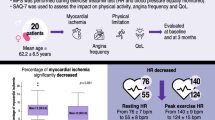Summary
In a double-blind, placebo-controlled, randomized trial of treadmill exercise tolerance in six patients with chronic stable angina, intravenous mivazerol 1 µg, 2 µg, and 3 µg/kg increased in the time to onset of angina by 39%, 48%, and 76%; the time to 1-mm ST depression by 36%, 76%, and 104%; and total exercise duration by 15%, 23%, and 30%, respectively. In a subsequent double-blind, placebo-controlled, randomized trial involving a further 12 patients, a single oral dose of mivazerol of 800 µg, 1200 µg, and 1600 µg increased the time to onset of angina by 4%, 11%, and 30%; the time to 1-mm ST depression by 33%, 43%, and 53%; and the total exercise duration by 10%, 18%, and 23%, respectively. Mivazerol is an imidazole derivative with agonist properties at the alpha2-adrenoceptor and appears to be an effective antianginal. Mivazerol may improve exercise performance by attenuating the effects of exercise-induced sympathetic nervous system activity on the ischemic myocardium.
Similar content being viewed by others
References
Maseri A. Medical therapy of chronic stable angina pectoris.Circulation 1990;82:2258–2262.
Kharkevitch T, Guyaux M, Gobert J, Wulfert E. Mivazerol. A new α2-receptor agonist reduces ischaemia produced by coronary occlusion in rats and dogs.Cardiovasc Drugs Ther 1991;5:S407.
Kharkevitch T, Noyer M, Guyaux M, Riemersma RA, Gobert JK, Wulfert E. Mivazerol, a new α2-adrenergic agonist with anti-ischaemic effects in animal models of myocardial ischaemia. In:Proc Eur Assoc Cardiothorac Anaesthesiologists, 1992.
Du XJ, Hoet B, Kharkevitch T, Riemersma RA. Mivazerol inhibits neuronal norepinephrine release during myocardial ischaemia.J Mol Cell Cardiol 1992;24:S21.
Bruce RA. Exercise testing of patients with coronary heart disease. Principles and normal standards of evaluation.Ann Clin Res 1971;3:323–332.
Prichard BNC, Aelling WH, Richardson GA. The action of intravenous oxprenolol, practolol, propranolol and sotalol on acute exercise tolerance in angina pectoris: The effect on heart rate and the electrocardiogram.Postgrad Med J 1970;43(Nov suppl):77–83.
Subramanian VB, Bowles MJ, Khurmi NS, Davies AB, Raftery EB. Randomised double-blind comparison of verapamil and nifedipine in chronic stable angina.Am J Cardiol 1982;50:696–703.
Thadani U, Fung HL, Darke AC, Parker JO. Oral isosorbide dinitrate in the treatment of angina pectoris.Circulation 1980;62:491–502.
Cocco G, Strozzi C, Haeusler G, Chu D, Amrein R, Padovan GC. The therapeutic value of clonidine in patients with coronary heart disease.Eur J Cardiol 1979;10:221–228.
Thomas MG, Quiroz AC, Rice JC, Sander GE, Giles TD. Anti-anginal effects of clonidine.J Cardiovasc Pharmacol 1986;8(Suppl 3):S69-S75.
Simoons ML, Tummers J, van Meurs-van Woezik H, van Domurg R. Alinidine, a new agent which lowers heart rate in patients with angina pectoris.Eur Heart J 1982;3:542–545.
Schurmans J, Piessens J, Kesteloot H, De Geest H. Comparative effects of alinidine and propranolol in ischaemic heart disease.Eur J Clin Pharmacol 1982;23:389–396.
Meinertz T, Kasper W, Meier R, et al. Alinidine in angina.Clin Pharmacol Ther 1983;34:770–776.
Mohrman DE, Feigl EO. Competition between sympathetic vasoconstriction and metabolic vasodilation in the canine coronary circulation.Circ Res 1978;42:79–86.
Heusch G, Deussen A. The effects of cardiac sympathetic nerve stimulation on perfusion of stenotic coronary arteries in the dog.Circ Res 1983;53:8–15.
Seitelberger R, Guth BD, Heusch G, Lee JD, Katayama K, Ross J Jr. Intracoronary α2-adrenergic receptor blockade attenuates ischaemia in conscious dogs during exercise.Circ Res 1988;62:536–542.
Kitakaze M, Hori M, Gotoh K, et al. Beneficial effects of α2-adrenoceptor activity on ischaemic myocardium during coronary hypoperfusion in dogs.Circ Res 1989;65:1632–1645.
Author information
Authors and Affiliations
Rights and permissions
About this article
Cite this article
Wright, R.A., Decroly, P., Kharkevitch, T. et al. Exercise tolerance in angina is improved by mivazerol—An alpha2-adrenoceptor agonist. Cardiovasc Drug Ther 7, 929–934 (1993). https://doi.org/10.1007/BF00877729
Received:
Accepted:
Issue Date:
DOI: https://doi.org/10.1007/BF00877729




